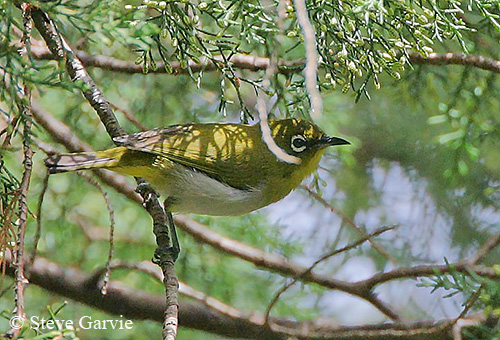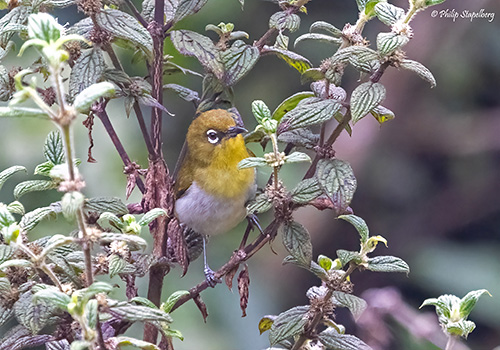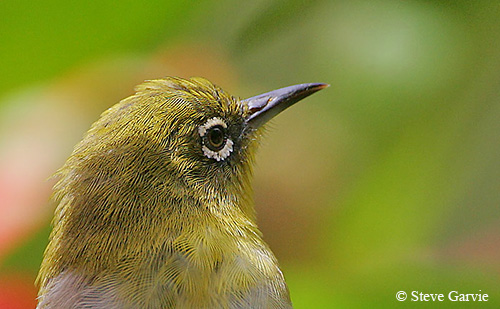
Fr: Zostérops de Ceylan
Ang: Sri Lanka White-eye Ceylon-White-eye
All: Ceylonbrillenvogel
Esp: Anteojitos Cingalés
Ita: Occhialino di Sri Lanka
Nd: Ceylonese Brilvogel
Sd: ceylonglasögonfågel
Photographers:
Steve Garvie
RAINBIRDER Photo galleries
Philip Stapelberg
GALLERY
Alan & Ann Tate
AA Bird Photography
Text by Nicole Bouglouan
Sources:
HANDBOOK OF THE BIRDS OF THE WORLD Vol 13 by Josep del Hoyo-Andrew Elliot-Jordi Sargatal - Lynx Edicions – ISBN: 9788496553453
Breeding biology of Sri Lanka White-eye Zosterops ceylonensis (Aves: Passeriformes: Zosteropidae) in tropical montane cloud forests, Sri Lanka
Non-sister Sri Lankan white-eyes (genus Zosterops) are a result of independent colonizations
Wikipedia, the free encyclopaedia
Home page
Page Passeriforme Order
Sri Lanka White-eye or Ceylon White-eye
Zosterops ceylonensis
Passeriformes Order – Zosteropidae Family
INTRODUCTION:
The Sri Lanka White-eye or Ceylon-White-eye is endemic to Sri Lanka where it frequents moist forests, plantations and scrublands. It is probably the commonest species of the higher hills, between 450 and 1,000 metres of elevation.
The diet is varied and includes insects, fruits, berries and nectar. Outside breeding season, it forages in small groups or larger mixed-flocks.
The Sri Lanka White-eye or Ceylon-White-eye nests in a cup-shaped structure made of plant material and placed among the dense foliage for better protection against predators. Both parents share the nesting duties.
The species is threatened by habitat loss caused by deforestation, agriculture and urban expansion. But currently, the Sri Lanka White-eye or Ceylon-White-eye is not globally threatened.
DESCRIPTION OF THE BIRD:
Biometrics:
Length: 11-12 cm
Weight: female: 12,5 g
The Sri Lanka White-eye adult male has olive-green upperparts. Both flight-feathers and rectrices are blackish-brown with broad, dark greenish edges.
On the underparts, throat and breast are greenish-yellow, but mostly greenish towards the edges. The undertail-coverts are yellow. Rest of underparts is greyish-white with darker flanks and a trace of yellow streak over the belly.

On the head, the crown is olive-green. Both lores and streak below the eye are dark grey, and there is some grey on the ear-coverts. The conspicuous white eyering is interrupted in front of the eye by a dark grey spot continuous with the lores.
The short, slender bill is blackish above, but the lower mandible is bluish-grey. It is slightly curved downwards.
The eyes are light brown.
Legs and feet are dark grey.
Male and female have similar appearance, but the female has less dark on the forehead.
The juvenile has slightly paler upperparts and slightly brighter yellow throat and breast. The white eyering is narrower.
RANGE:
The Sri Lanka White-eye is endemic to Sri Lanka where it occurs in hills and mountains.
HABITAT:
The Sri Lanka White-eye is found in both tropical and subtropical forests of Sri Lanka. It usually occurs at forest edge, in low isolated bushes, plantations (tea), scrublands and gardens.
The species can be seen from 450 metres in SW (Sinharaja) up to 1,000 metres of elevation.
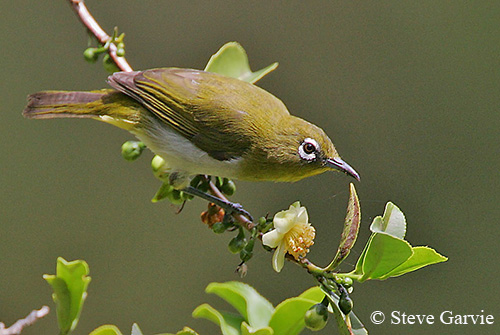
CALLS AND SONGS: SOUNDS BY XENO-CANTO
The Sri Lanka White-eye frequently vocalizes.
During the breeding season, they communicate by a variety of calls and songs. While they are interacting, the melodious sounds can be heard through the forest as the birds chase one another and forage together.
The common call is a high-pitched “cheep” similar to the chirp of a sparrow (genus Passer). We can also hear a short, thin chirp described as “chísíp”.
The song is a fairly prolonged phrase of sharp couplets or triplets varying in pitch, described as “chik chik chuk chik chik chuk-chuk chik”.
This song is usually heard before sunrise.
BEHAVIOUR IN THE WILD:
The Sri Lanka White-eye is primarily insectivorous, feeding on small moths and caterpillars, especially those of Homona coffearia.
This species also consumes nectar and contributes to the pollination of several plant species. The nectar is taken from blossoms. It also takes berries from trees and bushes. Arthropods are caught by gleaning from a surface while perched or hovering. It may also probe a crevice or other type of cavity, and it performs sallies to catch a prey in mid-air.
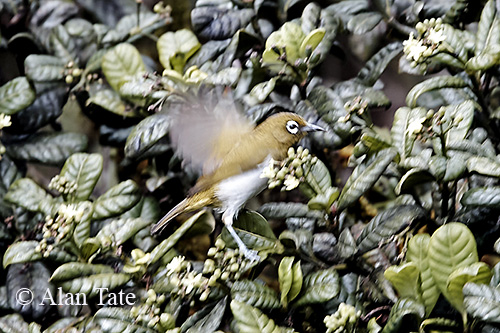
The Sri Lanka White-eye usually forages in flocks within the canopy. They are often seen engaging in social behaviour such as grooming, in order to strengthen the bonds within the groups.
The species is known for its agility and it is often observed hanging upside-down while foraging. It is always on the move, searching for prey, nectar and berries. The birds spread the seeds across their habitat, and maintain the health of the ecosystem.
The breeding behaviour of the species is not well known. But generally speaking, the white-eyes defend a small area around the nest, but they are not territorial outside the nesting site. They defend the nest vigorously with bill-snapping against intruders, and chasing them beyond the territory borders.
The Sri Lanka White-eye builds a cup-shaped nest made of plant materials. It is placed in dense vegetation or well-foliaged tree or bush to protect the site from predators. Both adults share the nesting duties.
The Sri Lanka White-eye is resident and endemic to Sri Lanka.
The short, rounded wings of these small birds do not allow a strong flying action. The flight, generally over short distances while foraging, is usually weak and undulating.
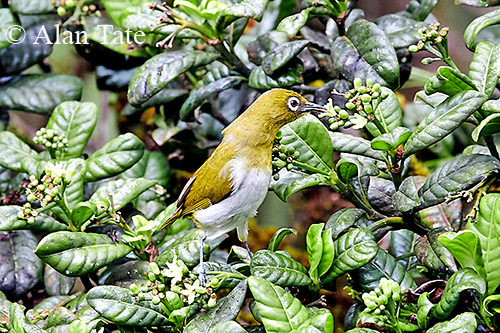
REPRODUCTION OF THIS SPECIES:
The breeding season takes place from March to May, with peak of egg-laying in March-April. There is a secondary season in August-September.
Both adults build the nest, a small but deep, cup-shaped structure made of grass, leaves, rootlets and green moss woven with cobwebs.
This structure is built within the dense foliage, suspended by the rim in the fork of a leafy twig, usually 2-4 metres above the ground.
The female lays 2-3 pale blue eggs. From an observation in January 2017-January 2028, the incubation period last 10-11 days, and the nestling period too.
Both adults share both incubation and chick rearing.
No more information.
